Troughs / Ball Drains
Related Config File Sections:
Every pinball machine will have some kind of ball trough / drain device. This is the place where the balls go when they drain from the playfield before they're ejected into the plunger lane.
In many cases, this device (or series of devices) holds multiple balls and is the location where unused balls are stored.
There are several different designs for troughs and drains that have been used over the past 70 years, and (as far as we know), MPF supports all of them. So regardless of what's in your machine, we're talking about whatever is under here:
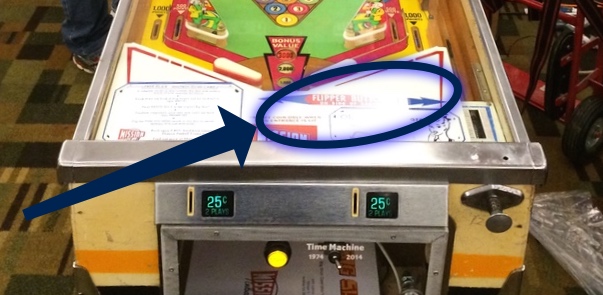
Here are the options:
- Modern trough with opto sensors
- Modern trough with mechanical switches
- Older style with two coils and switches for each ball
- Older style with two coils and only one ball switch
- Classic single ball, single coil
- Classic single ball, single coil, no shooter lane
Since there are so many different options, you need to first identify which type of trough or ball drain system your machine has. So look at the following pictures to match up what you have, and then follow the specific links to see how to configure MPF to use it in your machine.
Video on ball tracking in MPF:
Option 1: Modern trough with opto sensors
Modern-style troughs (which have been used since about 1993 or so) are mostly located underneath the playfield and hold the balls at an incline so they roll down to the end. There is a single coil which fires to eject a ball up and out where it's directed to the plunger lane.
Help us write it!
This section is unwritten or needs an update or edit. Can you help write it? Get your name in lights and geeky pinball bragging rights! Hit the magic sparkly wand to the right of the title to see this page source on GitHub. Then add/edit and submit your change. It's easy!
The advantage of modern troughs are (1) the balls entering are gravity-fed, meaning they only need one coil, and (2) they can hold a lot of balls. (Most hold 4-6 balls but you can buy ones that hold up to 8.)
If you have a modern-style trough with a circuit board on each side, that means your trough uses opto sensors to detect the presence of a ball. One of those circuit boards contains infrared LEDs which are always on which shoot invisible beams across the ball paths, and the board has sensors that detect if a light beam is broken, meaning a ball is sitting there blocking the path.
Common parts include:
- Williams: #A-16809
- Mantis Trough
- Stern #500-9820-00
If you have a modern trough with opto sensors, read the guide to continue.
Option 2: Modern trough with mechanical switches
Some modern-style troughs use mechanical switches to detect the balls rather than infrared opto boards. (Other than that, they're the same as the opto-based troughs.) Here's a photo of a modern trough with mechanical switches from a Stern Star Trek Premium machine:
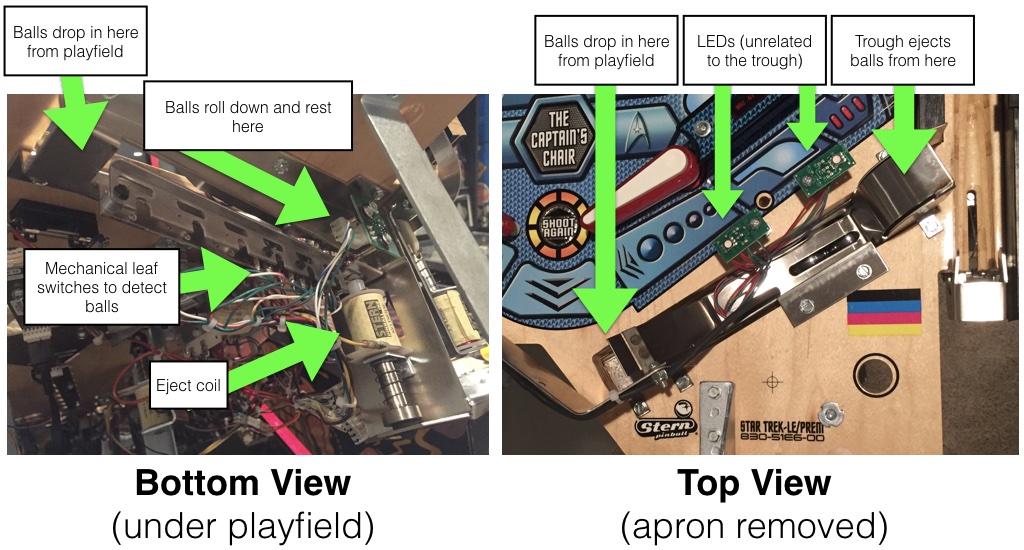
If you have a modern-style trough with mechanical switches instead of opto boards, then read the guide to continue.
Common parts include:
- Stern: #500-6318-24 (trough assembly), #535-8393-00 (center drain ball guide), #535-7329-01 (entry/exit scoop)
- Spooky: #100-0015-00 (4 balls) or #100-0016-00 (8 balls), #100-0002-00 (drain guide + enter exit scoop)
Option 3: Older style with two coils and switches for each ball
Many machines from the 1980s and early 1990s have a ball trough system that consists of two separate coils and where the balls stay "on top" of the playfield (under the apron).
In this case, when a ball drains, a coil in the drain area pulses to eject the ball up over a hump where the balls are stored. Then a second coil near the plunger lane is used to eject a single ball at a time into the plunger lane.
Some of these types "two coil" systems have multiple switches on the side that stores the balls, with there being one switch for each ball. That lets the machine know exactly how many balls are sitting there because each ball is sitting on a switch.
Here's a photo of this type of trough system from a Pin*Bot machine:
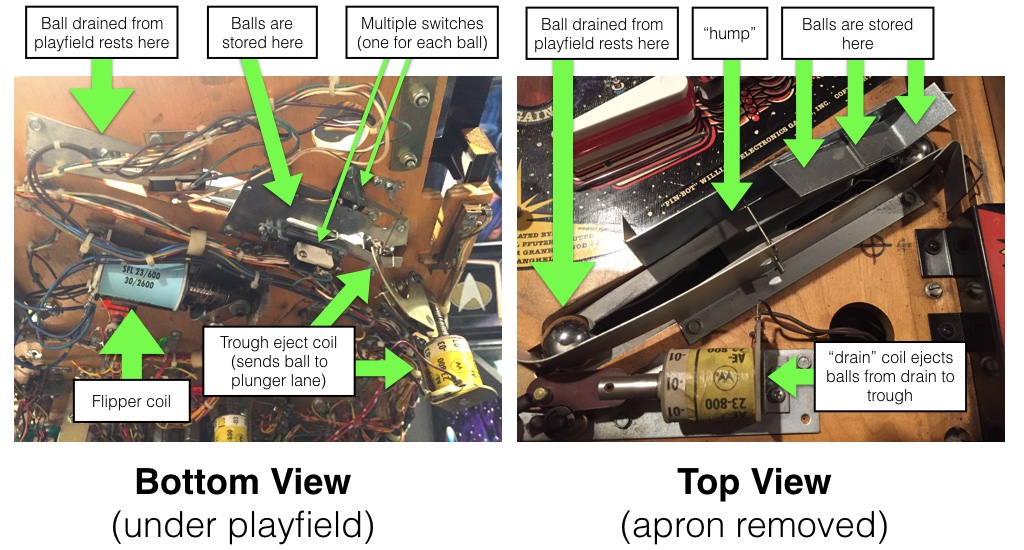
If you have this kind of trough system, read the guide to continue.
Option 4: Older style with two coils and only one ball switch
Another option is similar to Option 3 above, except there's only one switch on the trough side instead of separate switches for each ball. In these types of trough systems, the behavior of that switch changes depending on how many balls are in the trough.
If there are fewer than the max number of balls in the trough, when the drain coil pulses to eject the ball from the drain into the trough, the ball will roll over that trough switch, meaning it's activated momentarily and then deactivated again.
However, if the ball ejecting into the trough will be the final ball that will fill the trough, then that ball will rest on that trough switch, meaning that switch is solid active as long as the trough is full.
Here's a photo from a Gottlieb System 3 machine (Brooks 'n Dunn) which shows what this type of system looks like:
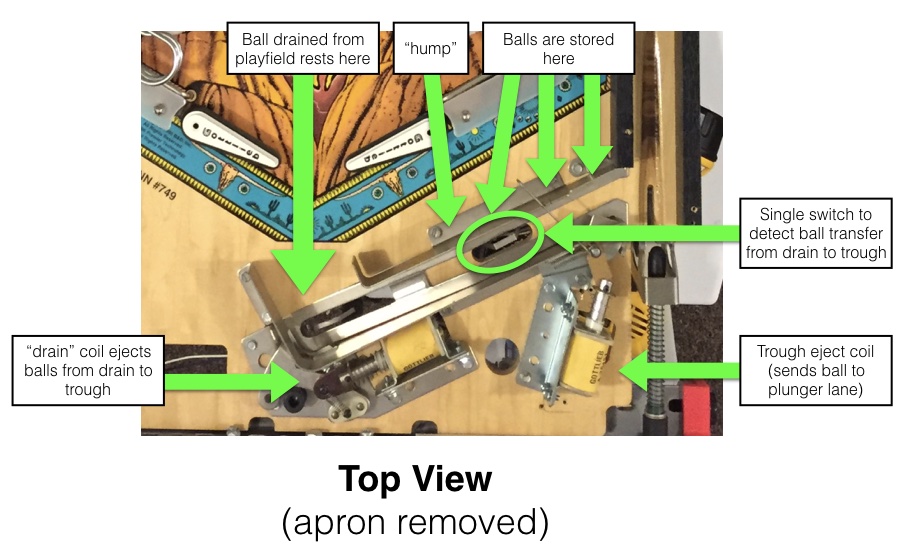
If your machine has a system similar to this, then read the guide to continue.
Option 5: Classic single ball, single coil
Older single-ball machines have a trough system that is on top of the playfield under the apron, but they only have a single coil near the ball drain position. The ball is stored in the drain area, and when it needs to be ejected, a coil pulses to eject it from the drain all the way into the plunger lane in a single action.
Here's an example from Gottlieb Big Shot:
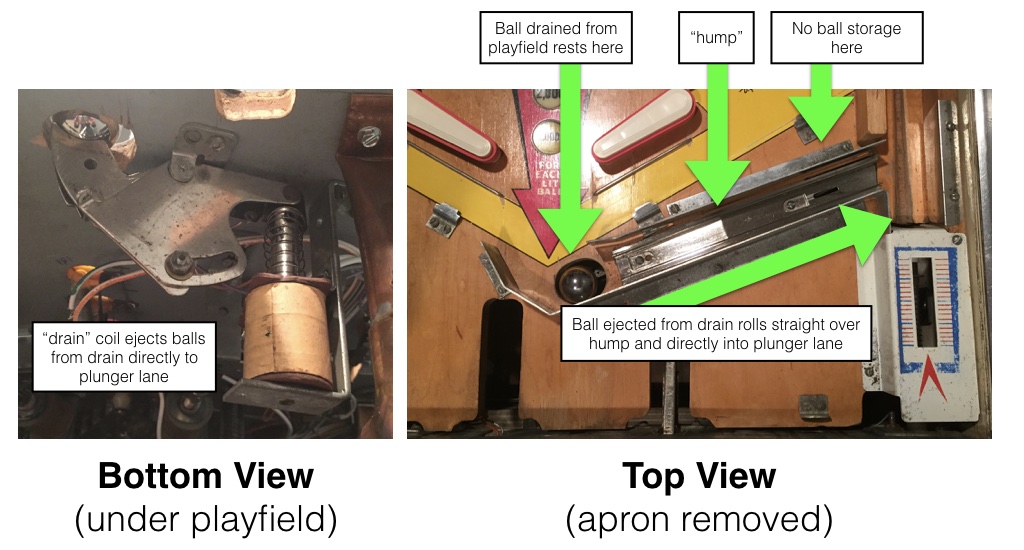
If you have a system like this, read the guide to continue.
Option 6: Classic single ball, single coil, no shooter lane
Very similar to Option 5 but the drain directly ejects back into the playfield. There is no shooter lane. This was used in early EM machines.
Here's an example from Gottlieb Playball:
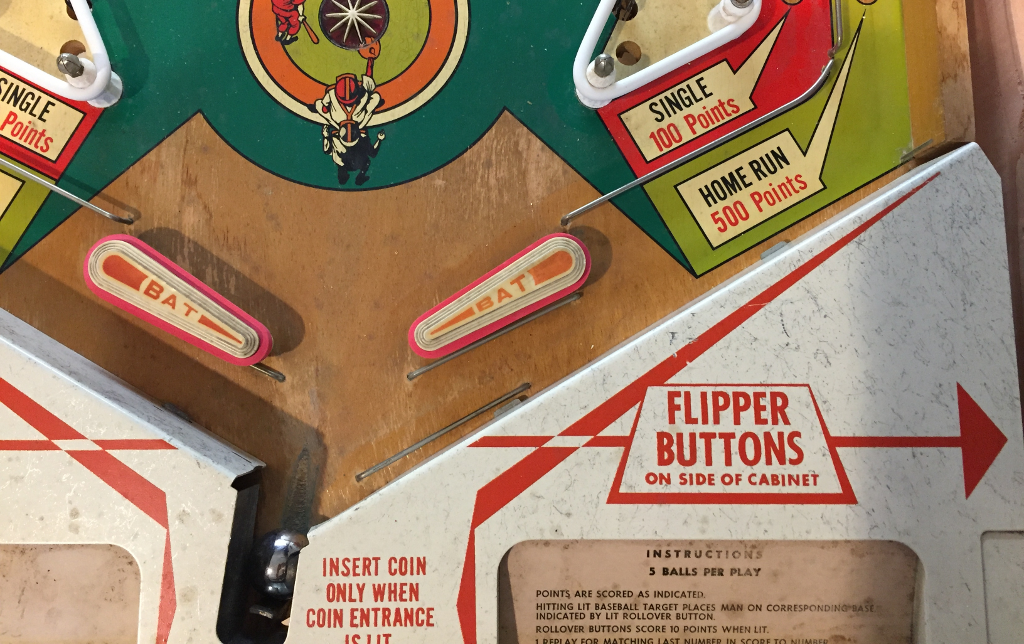
If you have a system like this, read the guide to continue.
Option 7: Something we haven't seen yet
If you're using MPF with a machine that has some kind of trough or drain system that we haven't covered here, we would like to know about it so we can write a how to guide and/or add support for it in MPF.
As far as we know, however, these 6 options should cover everything. For example, you might have a machine that you think is different, but when you really look at it, it's just a weird form of one of these 6 options. (Bally Fathom is a great example of this. It's like a classic single-ball trough where there is a drain that ejects a ball all the way into the plunger lane, but there are two additional switches in the apron wall where balls rest before they land in the drain device. That style of drain and trough is actually configured using Option 2, the modern trough with mechanical switches.)
If you have something weird that you can't figure out, we're happy to help! Just post a photo of it to community forum and we'll go from there.
Related How To guides:
Related Events
- ball_drain
- balldevice_ball_missing
- balldevice_balls_available
- balldevice_(name)_ball_missing
- balldevice_captured_from_(captures_from)
- balldevice_(name)_ball_eject_attempt
- balldevice_(name)_ball_eject_failed
- balldevice_(name)_ball_eject_success
- balldevice_(name)_ejecting_ball
Something missing or wrong? You can fix it!
This website is edited by people like you! Is something wrong or missing? Is something out of date, or can you explain it better?
Please help us! You can fix it yourself and be an official "open source" contributor!
It's easy! See our Beginner's guide to editing the docs.
Page navigation via the keyboard: < >
You can navigate this site via the keyboard. There are two modes:
General navigation, when search is not focused:
- F , S , / : open search dialog
- P , , : go to previous page
- N , . : go to next page
While using the search function:
- Down , Up : select next / previous result
- Esc , Tab : close search
- Enter : go to highlighted page in the results